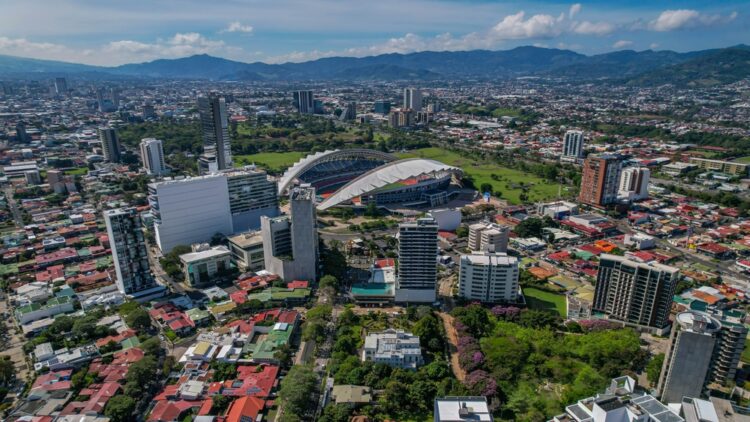There’s a strange fact about Costa Rican people – while they’re enormously proud of their beautiful country, they cringe when you mention the capital.
“To be honest, it’s not somewhere we’re really proud of,” one tour guide told me. “If you only see San Jose, you haven’t seen our country.” An Uber driver taking me to the apartment I’d rented was equally discouraging. “Maybe you can take some day trips out of town to the coast,” he suggested apologetically.
I know Costa Rica is famous for its wildlife and nature, but as a city girl, I wanted to take in the culture, too. And (a sneaky confession here) I thought perhaps it might make a great retirement destination since numerous expats adore their life here.
As we drove past uninspiring buildings and run-down neighborhoods, I wondered if I’d made a mistake. But it was too late – I’d booked a five-day stay, and I was determined to make the most of it.
So, would I recommend San Jose? As a holiday by itself, obviously not. But if you enjoy cities, then yes, give yourself three days here before you tour the country.
Let’s deal with the negatives first. Many pavements are uneven and edged by deep drains for the rainy season, so take care when walking. The public transport system didn’t link to Google Maps, so I couldn’t figure out the buses. Plus, it’s a sprawly place with pockets of activities rather than any sense of cohesion.
Some biologists at the university run a company called Oropopo (spectacled owl) that offers eco-friendly experiences for a few hours or a few days. I joined the Wild San Jose tour, where biologist Raquel Bone led a walk focused on conservation and restoration. She pointed out several sloths, and since the tree canopies here are less dense than in older forests, the furry little creatures were quite easy to spot. We also toured the butterfly garden, where the stars are giant blue morpho, whose iridescent blue wings suddenly snap shut to mimic the ferocious face of an owl.
Another San Jose highlight is the National Museum, where three or four hours can fly by. There’s a butterfly garden here, too, before you enter a long series of rooms and passageways in what used to be an army fortress. The fortress was made redundant in 1949 when President Jose Figueres Ferrer abolished the army and poured the military budget into education and healthcare instead. The museum spans the history of the indigenous people, the brutal Spanish conquerors, the development of modern society, and the environmental problems of today. Its grand displays of jade and gold meant I no longer needed to visit the nearby jade and gold museums, but I hadn’t run out of activities yet.
One morning I was setting off to join a free walking tour when the guide emailed a cancellation, warning of potential heavy rains. Not a cloud in the sky… so I quickly booked a different tour and met Jules, the guide, outside the National Theatre. Jules was equipped with umbrellas just in case since cloudbursts are common in the rainy season. He was an excellent storyteller, full of knowledge about the city and varying the pace with a break to sample some exotic fruits in a park.
If you want to see wildlife – which of course you do – there are some animal rescue centers within taxi distance of the city. One popular place is the Toucan Rescue Ranch, which houses toucans, parrots, sloths, ocelots, and monkeys rescued from the illegal pet trade or cared for if they’ve been found injured. Our guide told us that some would be released back into the wild once they were ready, although others would never be able to survive. The center does good work, but I did worry that some of the cages seemed too small.
Raquel from Oropopo recommended Rescate Wildlife as a better alternative, with walking trails and residents including jaguar, puma, tapir, monkeys, and toucans. In the past, they even had a lion, which arrived at Rescate under an admirable government policy to close the state-owned zoos and give animals their freedom.
For my stay in San Jose, I booked an apartment in Barrio Escalante, a residential area with a few core streets lined with craft beer pubs and welcoming restaurants. I was astonished to see train tracks running right through the neighborhood, connecting the city center to various suburbs and nearby towns. There are no protective barriers, so the trains hoot at every junction to alert motorists and pedestrians. It was funny watching the carriages chug right past the restaurants, but less entertaining at 6
am every day when the powerful hoots woke me up.
Still, I love train trips, and with more time, I’d have rattled along to Cartago, the former capital with some interesting history to investigate. But I ran out of time before I ran out of things to do.
Fast facts:
- Juan Santamaria International Airport is about an hour’s drive from San Jose.
- Uber is common and relatively cheap.
- US Dollars are accepted pretty much throughout the country, so you don’t need to change money.

